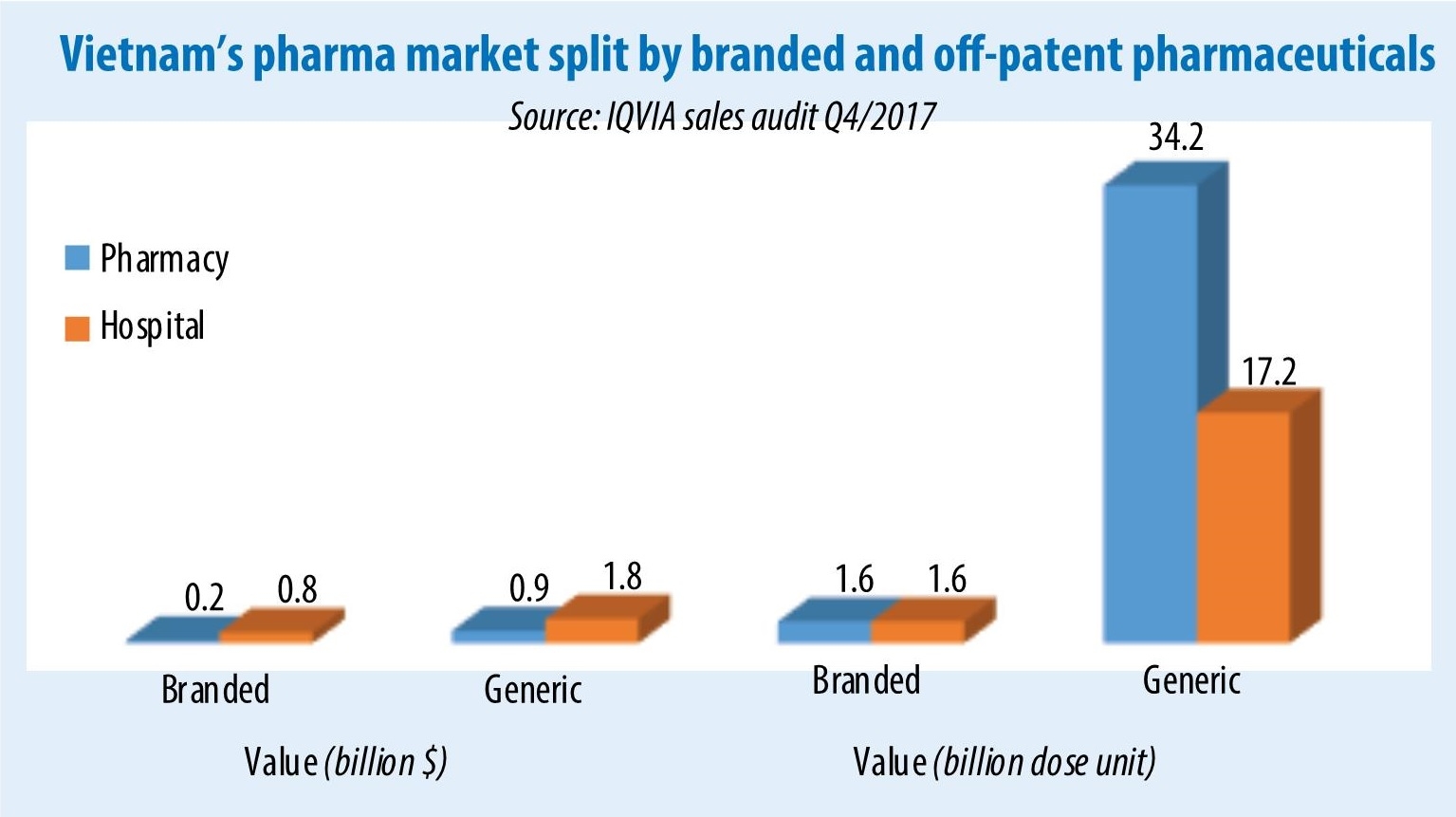 |
Next month, OPC Pharmaceutical JSC, one of the top five Vietnamese pharmaceutical firms, will organise its general shareholders’ meeting to discuss solutions to overcome current difficulties amid stiffening competition. In 2019, OPC witnessed on-year falls of 12 per cent in consolidated revenue and 23 per cent in consolidated after-tax profit.
Thorny path
Other big players are in the same boat as OPC. Traphaco JSC, the country’s second-largest publicly-traded drug maker, has announced its 2019 financial statement, with consolidated profit and revenue continuing to a downward trend after a tough year in 2018.
For instance, Traphaco made VND1.72 trillion in consolidated revenue ($74.8 million) last year, down 4.97 per cent on-year, while its pre-tax consolidated profit fell 0.63 per cent on-year to VND214.8 billion ($9.34 million). A company representative blamed the falls for the whole market’s poor state during this period. According to the third quarter 2019 report by IMS Health, the world’s leading provider of market intelligence to the pharmaceutical and healthcare industries, the over-the-counter channel saw no growth, while this channel makes up 92 per cent of Traphaco’s revenue.
Moreover, the delay in issuance of a circular on drug tenders hindered the firm’s efforts to take advantage of the ethical drugs or hospital channels.
Similarly, 2019 was also not a rosy year for Hau Giang Pharmaceutical JSC. The biggest publicly-traded drug maker reported consolidated revenue of VND4.41 trillion ($191.7 million), down from VND4.42 trillion ($192.2 million) in 2018. Its pre-tax consolidated profit dropped from VND731.8 billion ($31.8 million) in 2018 to VND713.2 billion ($31 million).
Although Vietnam’s third-largest domestic drug producer Domesco saw a slight rise in net revenue and profit in 2019, its net revenue of VND1.47 trillion ($64 million) was lower than in 2014’s VND1.49 trillion ($64.78 million).
Last year was not the first one that Vietnamese leading drug manufacturers performed poorly. They also faced similar challenges in 2018. Industry insiders blamed the unsatisfactory results among leading Vietnamese businesses for growing expansion among multinational corporations (MNCs), with Novartis, Sanofi, Zuellig Pharma, GSK, Pfizer, and DKSH being top movers.
Last year, Novartis and Sanofi became the first and second MNC to receive an import licence for pharmaceutical trading in Vietnam, thus enabling them to increase imports of brand-name drugs and vaccines into the country.
The Ministry of Health said that many other MNCs are waiting for an import licence, which could result in an increase in drug imports to Vietnam from the current 55 per cent of the total demand. If this happens, Traphaco, HDG, Domesco, and OPC will face more challenges in the future.
“Domestic drug firms might continue to face another downtrend in the future, especially when the EU-Vietnam Free Trade Agreement (EVFTA) comes into effect,” Vaibhav Saxena, a lawyer at Vietnam International Law Firm, told VIR. “If so, they will have few opportunities to increase market share, unless they have new effective business strategies.”
New solutions
Despite mounting competition, the Vietnamese drug giants are targeting higher profits and revenue growth this year. Specifically, Traphaco aims to make consolidated revenue of VND2 trillion ($87 million), up 16.2 per cent on-year. Imexpharm Pharmaceutical JSC – the country’s fourth-largest publicly-traded drug maker – also wishes to obtain total revenue of VND1.75 trillion ($76.08 million), and profit of VND260 billion ($11.3 million), up 23 and 18.1 per cent on-year, respectively.
In a bid to get out of the impasse, Vietnamese pharmaceutical firms are taking certain steps, such as investing in complying with the EU-GMP and PIC/S-GMP guides, which have been created to observe more stringent manufacturing and health standards and adapt to new technology. They are also exploring the potential of the ethical drugs channel (ETC) to shore up growth.
The companies have strengthened international co-operation in technology transfer to shorten research and development and manufacturing of new high-quality products, thus allowing them to meet the requirements to join the ETC.
“However,” said Saxena, “These companies will find it difficult to meet their targets because more favourable conditions for MNCs to import and trade drugs in Vietnam will come on the back of the EVFTA. It is projected that the agreement will bring more business and investment opportunities to EU pharmaceutical businesses in Vietnam and stiffen market competition.”
Saxena continued, “This landmark FTA will open the Vietnamese market in fields that the country has been seeking particular solutions to for years, such as intellectual property rights, direct pharmaceuticals imports, and tenders.”
According to the WTO Centre of the Vietnam Chamber of Commerce and Industry, pharmaceuticals imports from the EU into Vietnam will be more favourable, accessible, and direct under EVFTA commitments. Competition in tenders for groups of pharmaceuticals to open to EU bidders in the ETC will also be strengthened further. VIR
Bich Thuy

Foreign investors continue to target Vietnam’s pharmaceutical industry
Vietnam's pharmaceutical market has a lot of potential coming from the demographics, rising income and priority policies of the government.

The first time: Korean company acquires local pharmaceutical
JW Pharmaceutical Corporation acquired Euvipharm, becoming the first Korean company to take over a Vietnamese pharmaceutical company and operate it directly.
 Facing significant expansion from multinational corporations, Vietnamese drug giants took a hit in 2019 despite new strategies, signalling an uninspiring outlook for future growth.
Facing significant expansion from multinational corporations, Vietnamese drug giants took a hit in 2019 despite new strategies, signalling an uninspiring outlook for future growth.